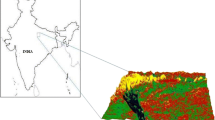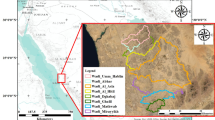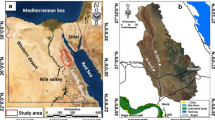Abstract
Floods represent a substantial and consequential from of natural disasters within Hanoi City. To minimize the detrimental effects on agriculture, an all-encompassing decision support instrument is necessary for flood management and alert systems. The primary aim of the current study is to delineate flood susceptible regions by employing SPOT satellite imagery and a hybrid Principal Component Analysis-Support Vector Machine (PCA-SVM) model, thereby gauging the influence of floods on land utilization for agricultural purposes in Hanoi City. The prediction results demonstrate a high model performance with R2test = 0.904, and AUC = 0.921. Areas classified as exhibiting high to very high flood susceptible encompass 55.882% of the overall expanse, while those classified as having low and very low flood risk account for 10.357% and 6.278% respectively. The amalgamation of satellite imagery and the PCA-SVM model in the formulation of flood susceptible zoning maps confers valuable insights to bolster flood prevention endeavors. The current research findings will make a substantial contribution to the strategic planning and preservation of food security for the nation.









Similar content being viewed by others
References
Ahmadlou, M., Karimi, M., Alizadeh, S., Shirzadi, A., Parvinnejhad, D., Shahabi, H., Panahi, M.: Flood susceptibility assessment using integration of adaptive network-based fuzzy inference system (ANFIS) and biogeography-based optimization (BBO) and BAT algorithms (BA). Geocarto Int. 34, 1252–1272 (2019). https://doi.org/10.1080/10106049.2018.1474276
Al-Abadi, A.M.: Map** flood susceptibility in an arid region of southern Iraq using ensemble machine learning classifiers: A comparative study. Arab. J. Geosci. 11, 218 (2018). https://doi.org/10.1007/s12517-018-3584-5
Anh, D.T.N.: Application of machine learning in analyzing the impact of urbanization on the green space pattern in Hanoi City (Thesis). (2023)
Anh, D.T.N.: Quantitative study of rice biomass in Hanoi city area using remote sensing and GIS technology (Thesis). (2021)
Bhattacharya, B., Mazzoleni, M., Ugay, R.: Flood Inundation Map** of the sparsely gauged large-scale Brahmaputra Basin using Remote Sensing products. Remote Sens. 11, 501 (2019). https://doi.org/10.3390/rs11050501
Brakenridge, G.R., Knox, J.C., Paylor, E.D., Magilligan, F.J.: Radar remote sensing aids study of the Great Flood of 1993. Eos Trans. Am. Geophys. Union. 75, 521–527 (1994). https://doi.org/10.1029/EO075i045p00521
Cao, C., Dragićević, S., Li, S.: Land-use change detection with convolutional neural network methods. Environments. 6, 25 (2019)
Chen, W., Hong, H., Li, S., Shahabi, H., Wang, Y., Wang, X., Ahmad, B.B.: Flood susceptibility modelling using novel hybrid approach of reduced-error pruning trees with bagging and random subspace ensembles. J. Hydrol. 575, 864–873 (2019)
Amitrano, D., Di Martino, G., Iodice, A., Riccio, D., Ruello, G.: IEEE Trans. Geosci. Remote Sens. 56, 3290–3299 (2018). https://doi.org/10.1109/TGRS.2018.2797536 Unsupervised Rapid Flood Map** Using Sentinel-1 GRD SAR Images
Do, A.N.T., 2024. Assessing the Impact of Habitat Fragmentation on the Distribution of Juvenile and Larval Sillago Species in the Ka Long Estuary Located in Northern Vietnam. Ocean Sci. J. 59, 24. https://doi.org/10.1007/s12601-024-00149-y
Do, A.N.T., Do, T.A.T., Van Pham, L., Tran, H.D., 2024. Assessment of the role of mangroves for Periophthalmus modestus applying machine learning and remote sensing: a case study in a large estuary from Vietnam. Aquat. Ecol. https://doi.org/10.1007/s10452-024-10111-8
Do, A.N.T., Tran, H.D.: Application of deep learning in assessing the impact of flooding on the endangered freshwater fish Neolissochilus benasi (Cyprinidae) in a northern province of Vietnam. Aquat. Ecol. (2023a). https://doi.org/10.1007/s10452-023-10056-4
Do, A.N.T., Tran, H.D., Ashley, M.: Employing a novel hybrid of GA-ANFIS model to predict distribution of whiting fish larvae and juveniles from tropical estuaries in the context of climate change. Ecol. Inf. 71, 101780 (2022a). https://doi.org/10.1016/j.ecoinf.2022.101780
Do, A.N.T., Tran, H.D., Ashley, M., Nguyen, A.T.: Monitoring landscape fragmentation and aboveground biomass estimation in Can Gio Mangrove Biosphere Reserve over the past 20 years. Ecol. Inf. 101743 (2022b). https://doi.org/10.1016/j.ecoinf.2022.101743
Do, A.N.T., Tran, H.D.: Combining a deep learning model with an optimization algorithm to detect the dispersal of the early stages of spotted butterfish in northern Vietnam under global warming. Ecol. Inf. 102380 (2023b). https://doi.org/10.1016/j.ecoinf.2023.102380
Do, A.N.T., Tran, H.D., Do, T.A.T.: Impacts of urbanization on heat in Ho Chi Minh, southern Vietnam using U-Net model and remote sensing. Int. J. Environ. Sci. Technol. (2023). https://doi.org/10.1007/s13762-023-05118-x
Do, A.N.T., Tran, H.D.: Potential application of artificial neural networks for analyzing the occurrences of fish larvae and juveniles in an estuary in northern Vietnam. Aquat. Ecol. (2023c). https://doi.org/10.1007/s10452-022-09959-5
Do, T.A.T., Do, A.N.T., Tran, H.D.: Quantifying the spatial pattern of urban expansion trends in the period 1987–2022c and identifying areas at risk of flooding due to the impact of urbanization in Lao Cai city. Ecol. Inf. 101912 (2022). https://doi.org/10.1016/j.ecoinf.2022.101912
Gao, J.B., Gunn, S.R., Harris, C.J.: SVM regression through variational methods and its sequential implementation. Neurocomputing Support Vector Machines. 55, 151–167 (2003). https://doi.org/10.1016/S0925-2312(03)00365-5
Hagos, Y.G., Andualem, T.G., Yibeltal, M., Mengie, M.A.: Flood hazard assessment and map** using GIS integrated with multi-criteria decision analysis in upper Awash River basin, Ethiopia. Appl. Water Sci. 12, 148 (2022). https://doi.org/10.1007/s13201-022-01674-8
Hailin, Z., Yi, J., Xuesong, Z., Gaoliao, J., Yi, Y., Baoyin, H.: GIS-based risk assessment for regional flood disaster, in: 2009 International Conference on Environmental Science and Information Application Technology. IEEE, pp. 564–567. (2009)
Hirabayashi, Y., Kanae, S., Emori, S., Oki, T., Kimoto, M.: Global projections of changing risks of floods and droughts in a changing climate. Hydrol. Sci. J. 53, 754–772 (2008)
Hsu, C.-Y., Li, W.: Learning from Counting. Leveraging Temporal Classification for Weakly Supervised Object Localization and Detection (2021)
Hua, A.K.: Land Use Land Cover changes in detection of Water Quality: A study based on Remote Sensing and Multivariate statistics. J. Environ. Public. Health. 2017(e7515130) (2017). https://doi.org/10.1155/2017/7515130
Kattenborn, T., Leitloff, J., Schiefer, F., Hinz, S.: Review on convolutional neural networks (CNN) in vegetation remote sensing. ISPRS J. Photogramm Remote Sens. 173, 24–49 (2021)
Khan, T.A., Shahid, Z., Alam, M., Su’ud, M.M., Kadir, K.: Early flood risk assessment using machine learning: A comparative study of svm, q-svm, k-nn and lda, in: 2019 13th International Conference on Mathematics, Actuarial Science, Computer Science and Statistics (MACS). IEEE, pp. 1–7. (2019)
Klemas, V.: Remote sensing of floods and flood-prone areas: An overview. J. Coast Res. 31, 1005–1013 (2015)
Lee, W.-K., Mohamad, I.N.: Flood Economy Appraisal: An overview of the Malaysian scenario. In: Hassan, R., Yusoff, M., Ismail, Z., Amin, N.M., Fadzil, M.A. (eds.) InCIEC 2013, pp. 263–274. Springer Singapore, Singapore (2014). https://doi.org/10.1007/978-981-4585-02-6_23
Lin, B., Wicks, J.M., Falconer, R.A., Adams, K.: Integrating 1D and 2D hydrodynamic models for flood simulation. Proc. Inst. Civ. Eng. - Water Manag. 159, 19–25 (2006). https://doi.org/10.1680/wama.2006.159.1.19
Lin, L., Di, L., Yu, E.G., Kang, L., Shrestha, R., Rahman, M.S., Tang, J., Deng, M., Sun, Z., Zhang, C.: A review of remote sensing in flood assessment, in: 2016 Fifth International Conference on Agro-Geoinformatics (Agro-Geoinformatics). IEEE, pp. 1–4. (2016)
Liu, Q., Qin, Y., Zhang, Y., Li, Z.: A coupled 1D–2D hydrodynamic model for flood simulation in flood detention basin. Nat. Hazards. 75, 1303–1325 (2015). https://doi.org/10.1007/s11069-014-1373-3
Liu, W.-C., Wu, C.-Y.: Flash flood routing modeling for levee-breaks and overbank flows due to typhoon events in a complicated river system. Nat. Hazards. 58, 1057–1076 (2011). https://doi.org/10.1007/s11069-010-9711-6
Loc, N.D., Yin, C.T., Mei, C.H., Van, H.T., Phuong, T.T., Son, N.T., Anh, D.T.N., Huong, B.T., Huy, N.Q.: Flood susceptibility assessment in central region of Vietnam based on ensemble fuzzy logic and multivariate analysis. Urban Arhit Construcţii. 13, 29–44 (2022)
Moharram, M.A., Sundaram, D.M.: Land Use and Land Cover Classification with Hyperspectral Data: A comprehensive review of methods, challenges and future directions. Neurocomputing. (2023)
Mosavi, A., Ozturk, P., Chau, K.: Flood prediction using machine learning models: Literature review. Water. 10, 1536 (2018)
Mou, L., Ghamisi, P., Zhu, X.X.: Deep recurrent neural networks for hyperspectral image classification. IEEE Trans. Geosci. Remote Sens. 55, 3639–3655 (2017)
Nahuelhual, L., Carmona, A., Lara, A., Echeverría, C., González, M.E.: Land-cover change to forest plantations: Proximate causes and implications for the landscape in south-central Chile. Landsc. Urban Plan. 107, 12–20 (2012)
Peng, J., Peng, F.-L.: A GIS-based evaluation method of underground space resources for urban spatial planning: Part 1 methodology. Tunn. Undergr. Space Technol. 74, 82–95 (2018)
Pham, T.V., Do, T.A.T., Tran, H.D., Do, A.N.T.: Assessing the impact of ecological security and forest fire susceptibility on carbon stocks in Bo Trach district, Quang Binh province. Vietnam Ecol. Inf. 74, 101962 (2023a). https://doi.org/10.1016/j.ecoinf.2022.101962
Pham, T.V., Thi Do, T.A., Tran, H.D., Thi Do, A.N.: Assessing groundwater potential for mitigating salinity issues in agricultural areas of southern Dong Nai Province. Vietnam Groundw. Sustain. Dev. 25, 101177 (2024). https://doi.org/10.1016/j.gsd.2024.101177
Pham, V.T., Do, T.A.T., Tran, H.D., Do, A.N.T.: Classifying forest cover and map** forest fire susceptibility in Dak Nong Province, Vietnam utilizing remote sensing and machine learning. Ecol. Inf. 102392 (2023b). https://doi.org/10.1016/j.ecoinf.2023.102392
Rajendran, G.B., Kumarasamy, U.M., Zarro, C., Divakarachari, P.B., Ullo, S.L.: Land-use and land-cover classification using a human group-based particle swarm optimization algorithm with an LSTM Classifier on hybrid pre-processing remote-sensing images. Remote Sens. 12, 4135 (2020)
Costache, R.: Water Resour. Manag. 33, 3239–3256 (2019). https://doi.org/10.1007/s11269-019-02301-z Flood Susceptibility Assessment by Using Bivariate Statistics and Machine Learning Models - A Useful Tool for Flood Risk Management
Su, X., Shao, W., Liu, J., Jiang, Y., Wang, K.: Dynamic assessment of the impact of flood disaster on economy and population under extreme rainstorm events. Remote Sens. 13, 3924 (2021)
Wu, H., Prasad, S.: Convolutional recurrent neural networks for hyperspectral data classification. Remote Sens. 9, 298 (2017)
Xu, X., Wang, X.: An Adaptive Network Intrusion Detection Method Based on PCA and Support Vector machines. In: Li, X., Wang, S., Dong, Z.Y. (eds.) Advanced Data Mining and Applications. Lecture Notes in Computer Science, pp. 696–703. Springer Berlin Heidelberg, Berlin, Heidelberg (2005). https://doi.org/10.1007/11527503_82
Zaharia, L., Costache, R., Prăvălie, R., Ioana-Toroimac, G.: Map** flood and flooding potential indices: A methodological approach to identifying areas susceptible to flood and flooding risk. Case study: The Prahova catchment (Romania). Front. Earth Sci. 11, 229–247 (2017)
Zhao, P., Zettsu, K.: Convolution recurrent neural networks for short-term prediction of atmospheric sensing data, in: 2018 IEEE International Conference on Internet of Things (iThings) and IEEE Green Computing and Communications (GreenCom) and IEEE Cyber, Physical and Social Computing (CPSCom) and IEEE Smart Data (SmartData). IEEE, pp. 815–821. (2018)
Acknowledgements
This research did not receive specific grants from public, commercial, or not-for-profit sector funding agencies. The author thanks anonymous reviewers for their helpful comments and suggestions, which improved this manuscript.
Author information
Authors and Affiliations
Corresponding author
Ethics declarations
Conflict of interest
The author declares no conflict of interest.
Additional information
Publisher’s Note
Springer Nature remains neutral with regard to jurisdictional claims in published maps and institutional affiliations.
Rights and permissions
Springer Nature or its licensor (e.g. a society or other partner) holds exclusive rights to this article under a publishing agreement with the author(s) or other rightsholder(s); author self-archiving of the accepted manuscript version of this article is solely governed by the terms of such publishing agreement and applicable law.
About this article
Cite this article
Do, A.N.T. Utilizing a fusion of remote sensing data and machine learning models to forecast flood risks to agriculture in Hanoi City, Vietnam. Lett Spat Resour Sci 17, 21 (2024). https://doi.org/10.1007/s12076-024-00382-y
Received:
Accepted:
Published:
DOI: https://doi.org/10.1007/s12076-024-00382-y




